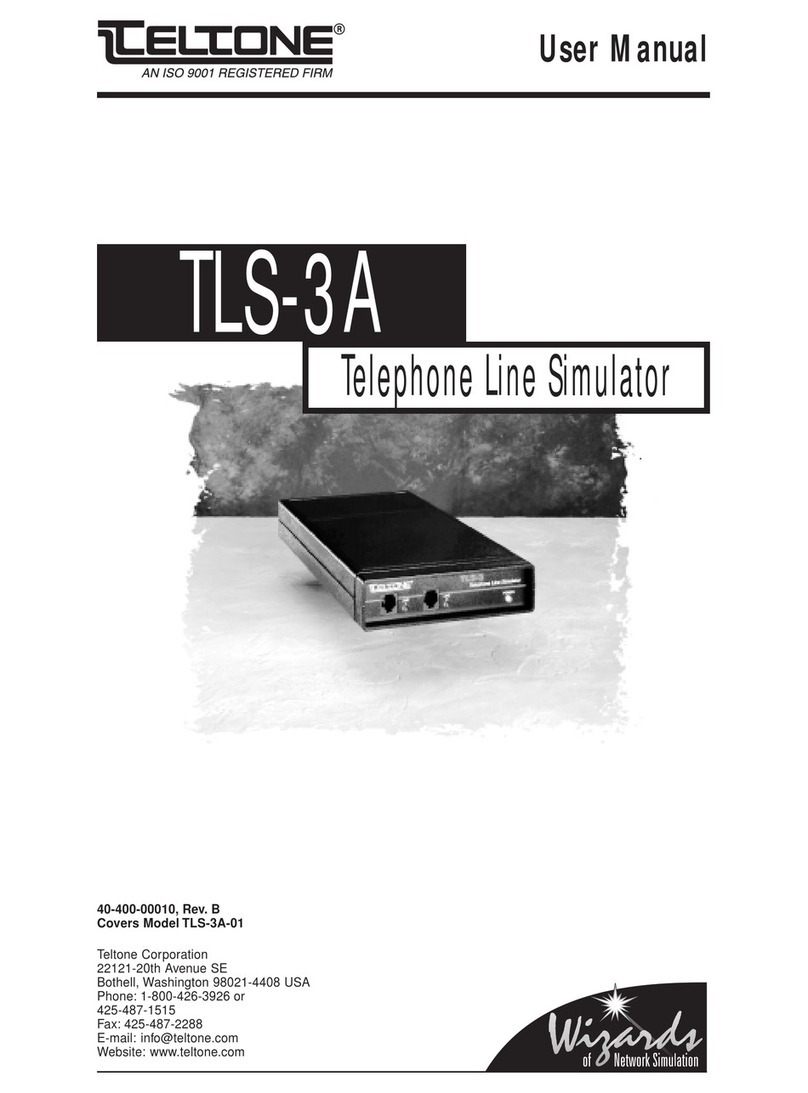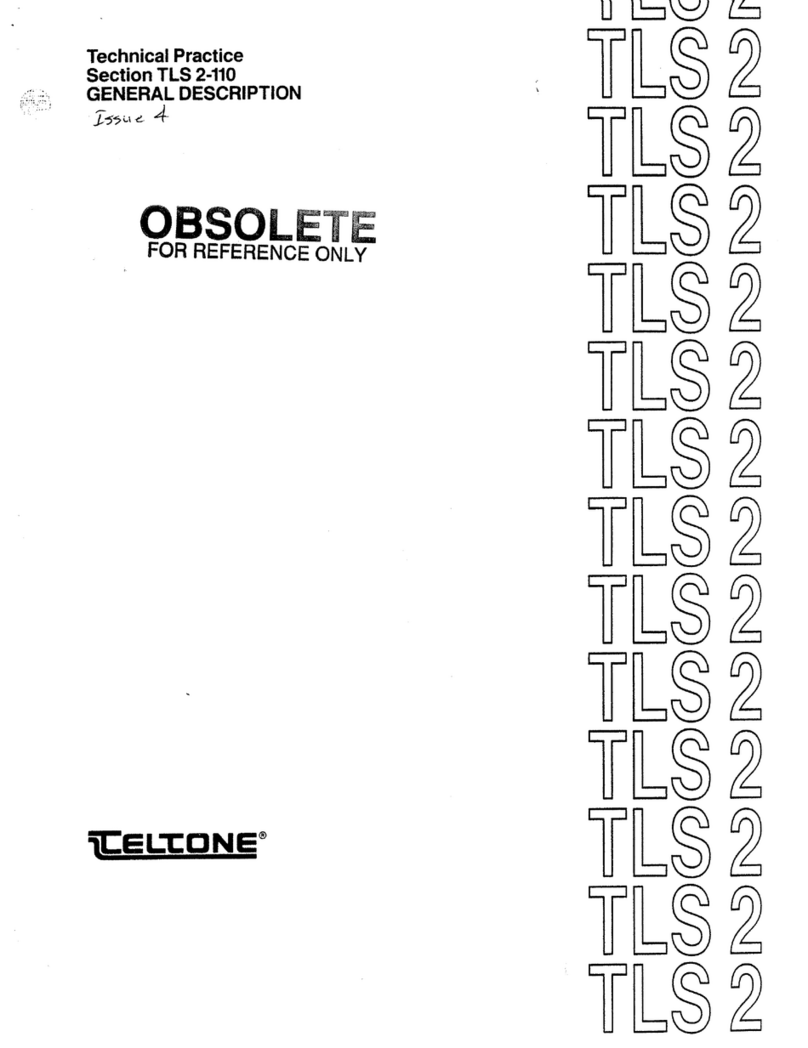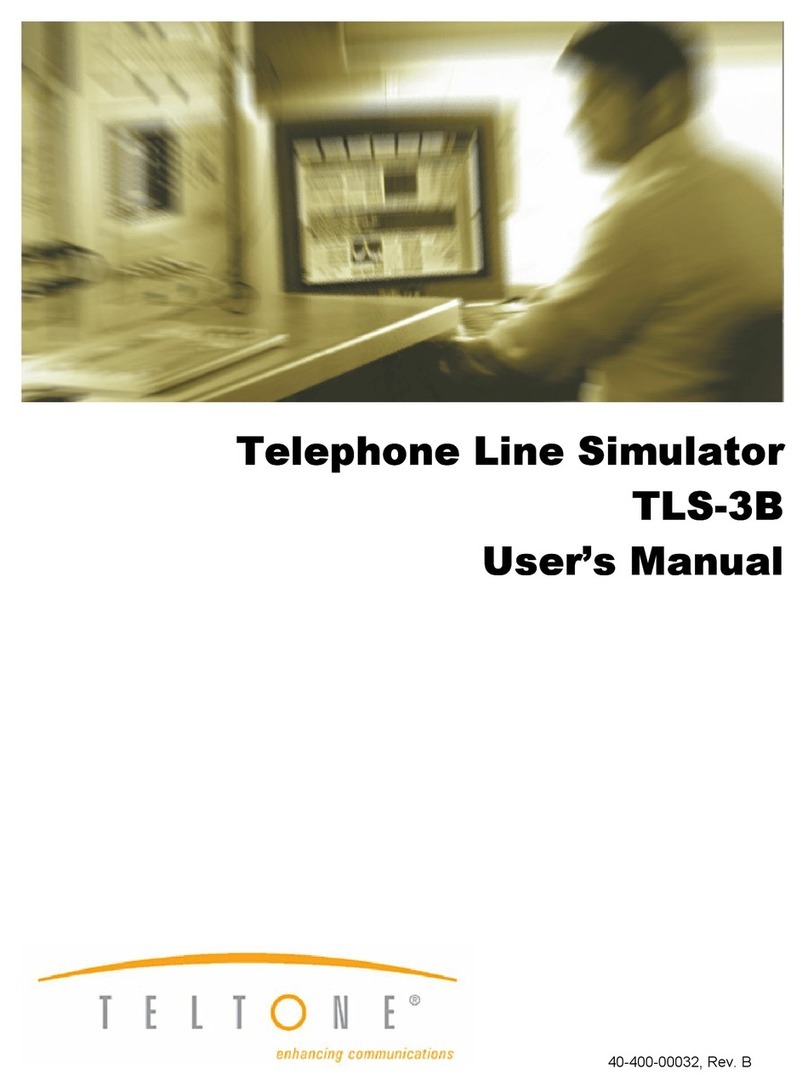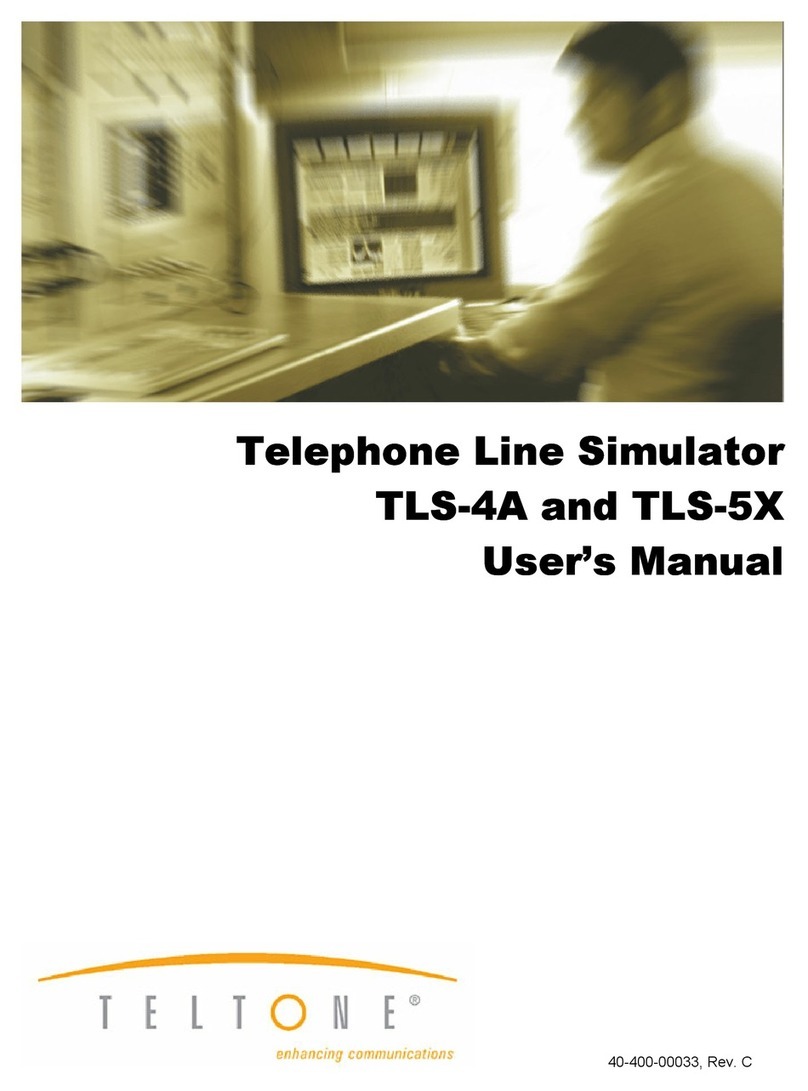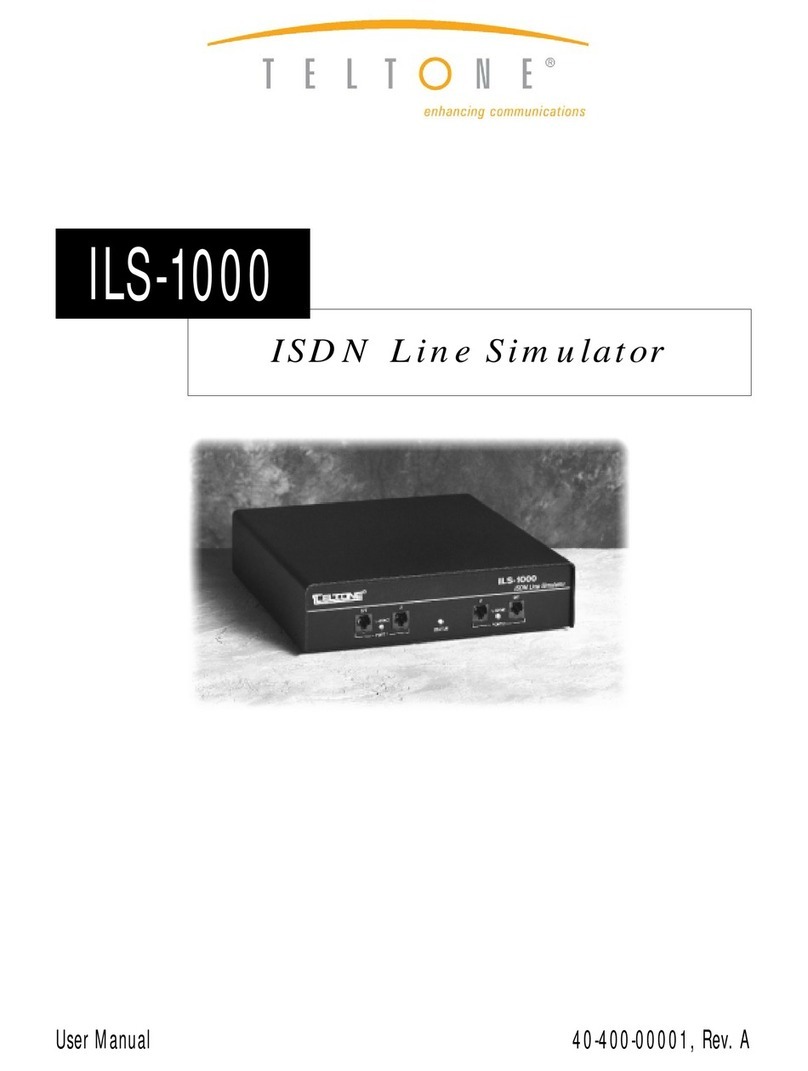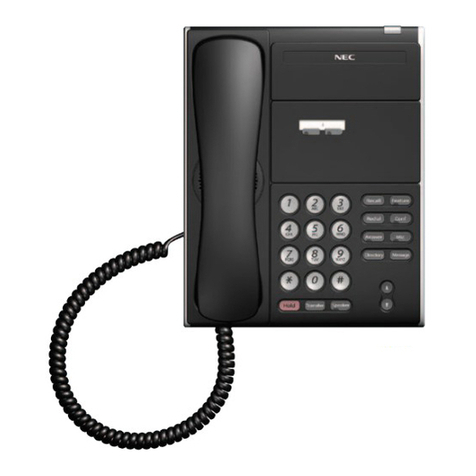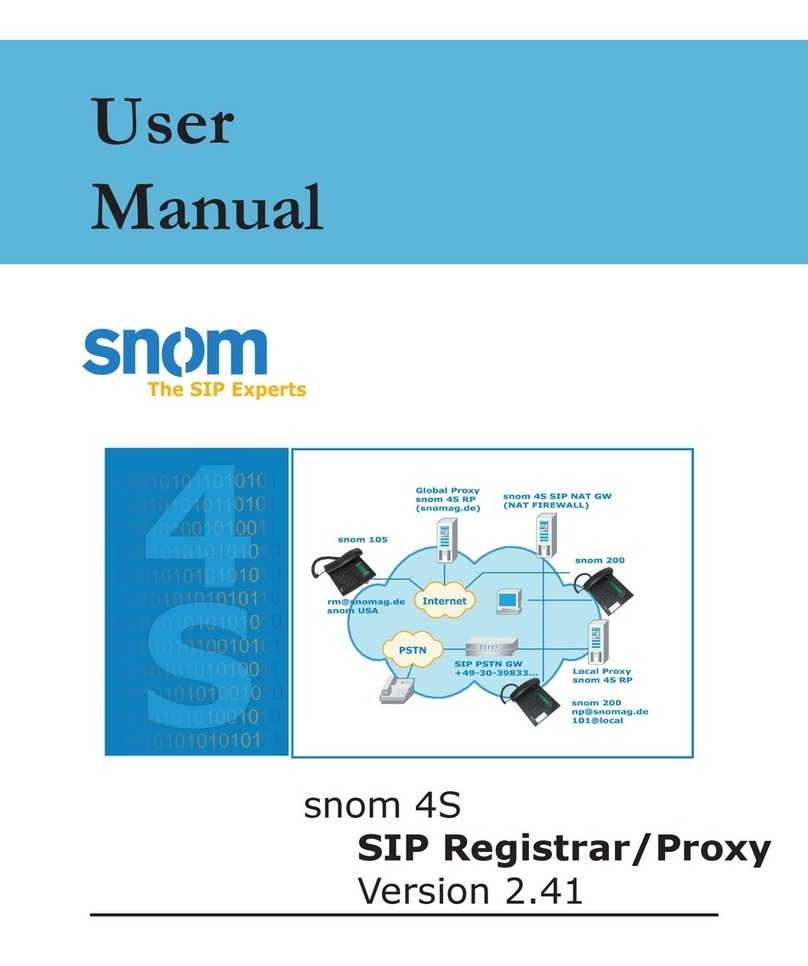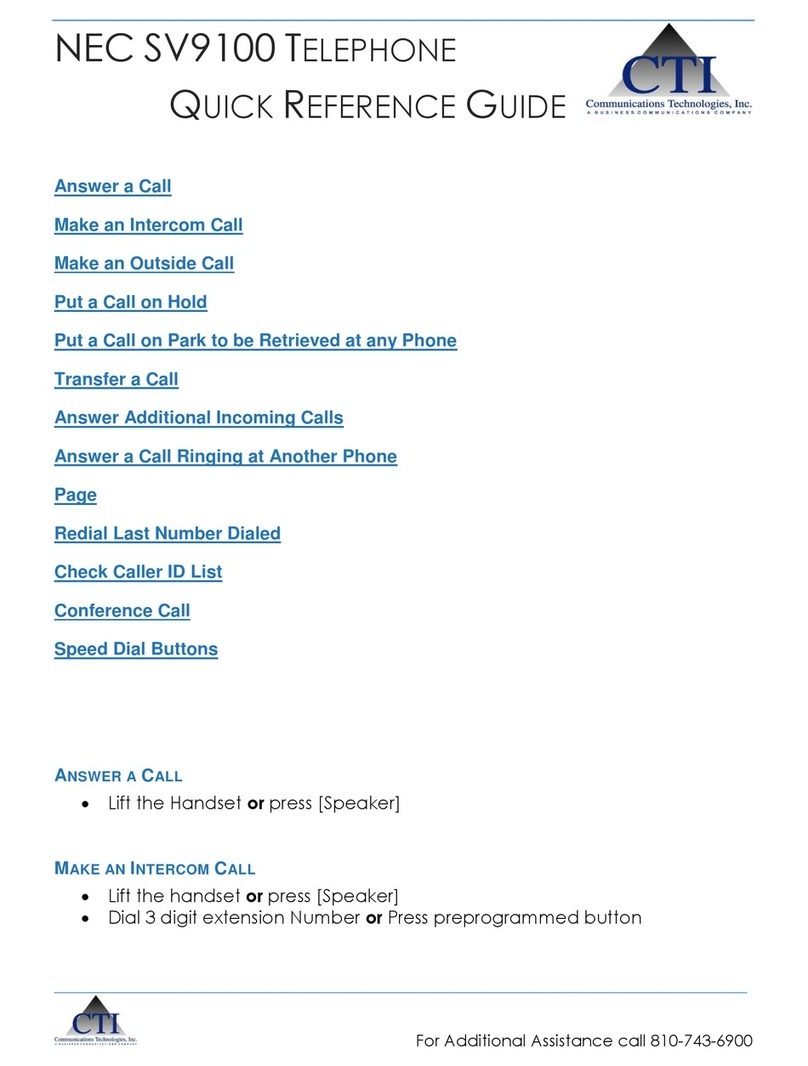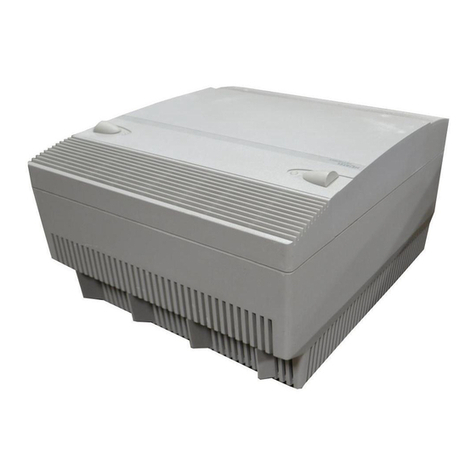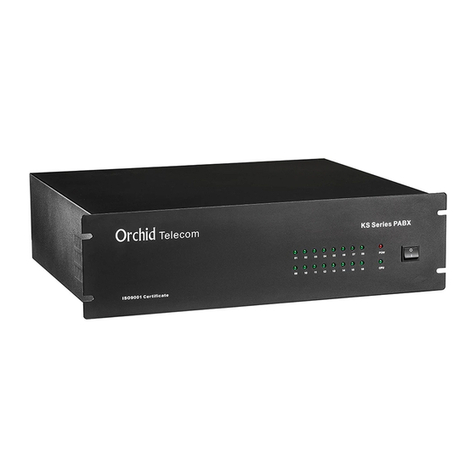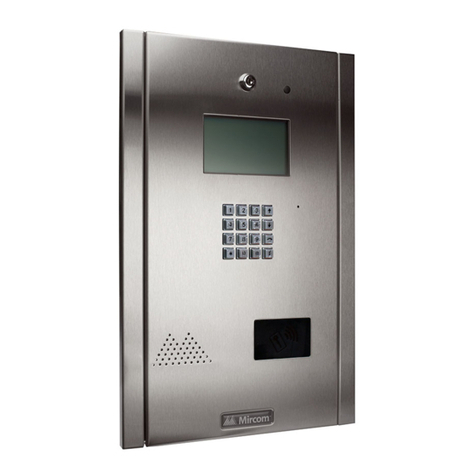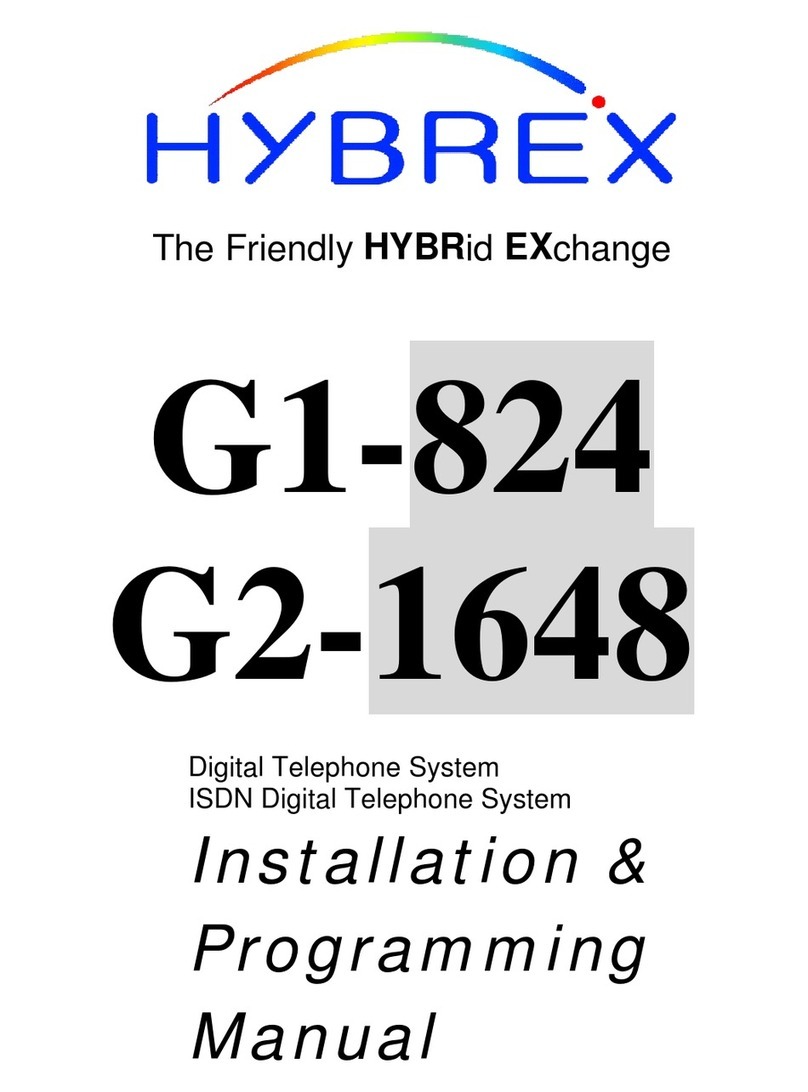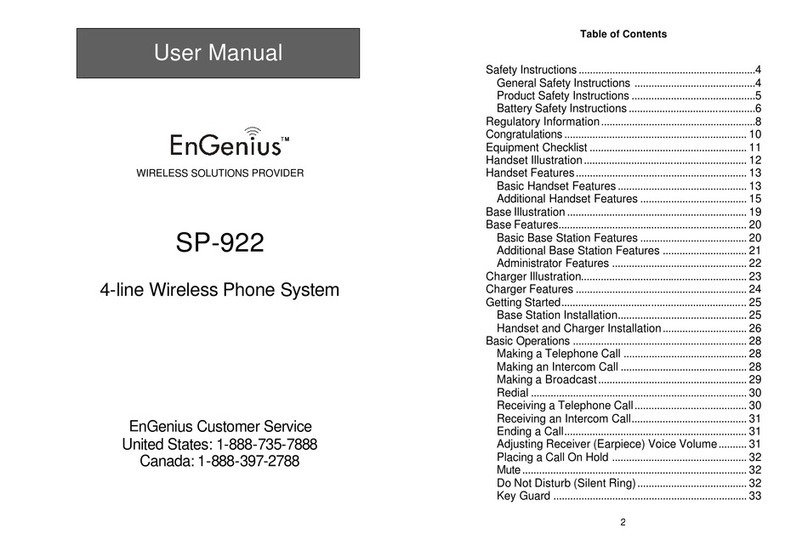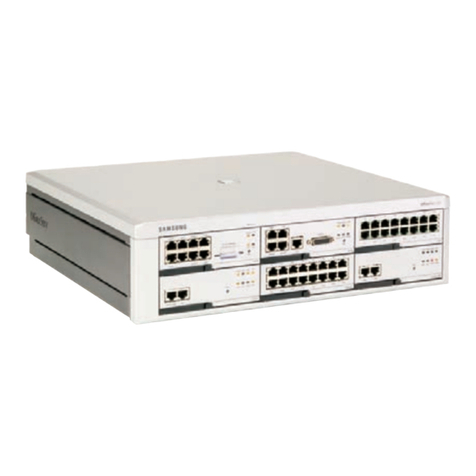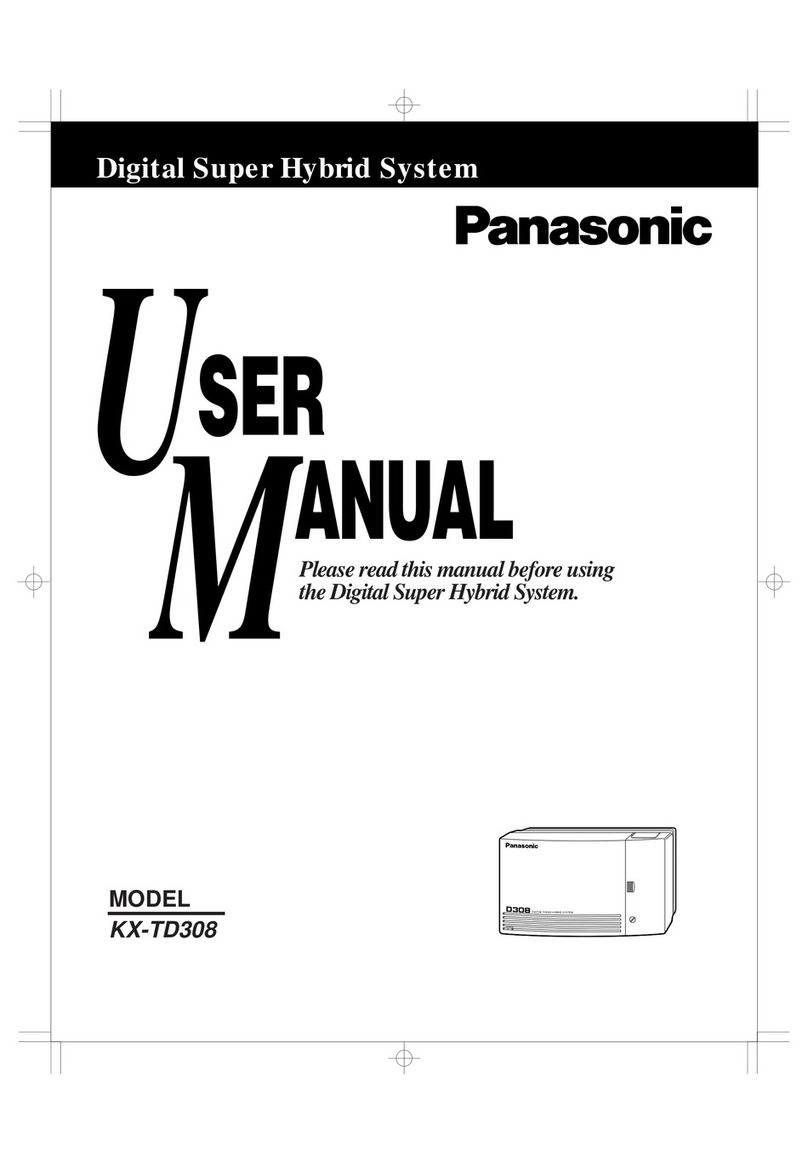Teltone TLS-5C User manual

Telephone Line Simulator
TLS-5C and TLS-5D
User’s Manual
40-400-00003, Rev. E

40-400-00003, Rev. E
Note
This manual covers Models TLS-5A, TLS-5B, TLS-5C, and TLS-5D.
Copyright Notice
Copyright © 1994 - 2003 Teltone Corporation
All Rights Reserved
Trademarks
Teltone is a registered trademark of Teltone Corporation.
Windows is a registered trademark of Microsoft Corporation.
Other company and product names may be trademarks or
registered trademarks of their respective owners.
Teltone Corporation
Bothell, Washington 98021 USA
Customer Service: 425-951-3388
Technical Support: 425-951-3390
Fax: 425-487-2288
Website: www.teltone.com

CONTENTS
IMPORTANT SAFETY INSTRUCTIONS. . . . . . . . . . . . . . . . . . . . . . . . . . . . . . . . . . . . . . . . . . . . . . . . . . . . . iii
COMPLIANCE INFORMATION . . . . . . . . . . . . . . . . . . . . . . . . . . . . . . . . . . . . . . . . . . . . . . . . . . . . . . . . . . . iv
Chapter 1: Overview . . . . . . . . . . . . . . . . . . . . . . . . . . . . . . . . . . . . . . . . . . . . . . . . . . . . . . . . . . . . . . . . . . . . 1
Features added with upgrade from -01 to -02 firmware. . . . . . . . . . . . . . . . . . . . . . . . . . . . . . . . . . 2
TLS-5C-01 and TLS-5D-01 Features. . . . . . . . . . . . . . . . . . . . . . . . . . . . . . . . . . . . . . . . . . . . . . . . 2
Table 1 Front Panel Switch Functions . . . . . . . . . . . . . . . . . . . . . . . . . . . . . . . . . . . . . . . . . . . . . . .4
Table 2 LED Indicators . . . . . . . . . . . . . . . . . . . . . . . . . . . . . . . . . . . . . . . . . . . . . . . . . . . . . . . . . . 4
Chapter 2: Feature Applications . . . . . . . . . . . . . . . . . . . . . . . . . . . . . . . . . . . . . . . . . . . . . . . . . . . . . . . . . . . 5
Uses for Off-Hook Modes . . . . . . . . . . . . . . . . . . . . . . . . . . . . . . . . . . . . . . . . . . . . . . . . . . . . . . . . 7
Figure 1 Telephone Line Simulator (TLS-5). . . . . . . . . . . . . . . . . . . . . . . . . . . . . . . . . . . . . . . . . . . 8
Uses for Hunt Mode . . . . . . . . . . . . . . . . . . . . . . . . . . . . . . . . . . . . . . . . . . . . . . . . . . . . . . . . . . . . 9
TLS-5C-01 & TLS-5D-01 Features . . . . . . . . . . . . . . . . . . . . . . . . . . . . . . . . . . . . . . . . . . . . . . . . . 9
Chapter 3: Installation . . . . . . . . . . . . . . . . . . . . . . . . . . . . . . . . . . . . . . . . . . . . . . . . . . . . . . . . . . . . . . . . . . 12
Demonstrating Equipment . . . . . . . . . . . . . . . . . . . . . . . . . . . . . . . . . . . . . . . . . . . . . . . . . . . . . . . 12
Restoring Defaults . . . . . . . . . . . . . . . . . . . . . . . . . . . . . . . . . . . . . . . . . . . . . . . . . . . . . . . . . . . . . 13
Installing Caller ID Equipment . . . . . . . . . . . . . . . . . . . . . . . . . . . . . . . . . . . . . . . . . . . . . . . . . . . . 13
Testing Installations . . . . . . . . . . . . . . . . . . . . . . . . . . . . . . . . . . . . . . . . . . . . . . . . . . . . . . . . . . . . 13
Chapter 4: Operation . . . . . . . . . . . . . . . . . . . . . . . . . . . . . . . . . . . . . . . . . . . . . . . . . . . . . . . . . . . . . . . . . . . 14
Basic Dialing . . . . . . . . . . . . . . . . . . . . . . . . . . . . . . . . . . . . . . . . . . . . . . . . . . . . . . . . . . . . . . . . . 14
Setting up a conference call: . . . . . . . . . . . . . . . . . . . . . . . . . . . . . . . . . . . . . . . . . . . . . . . . . . . . . 14
Transferring a call: . . . . . . . . . . . . . . . . . . . . . . . . . . . . . . . . . . . . . . . . . . . . . . . . . . . . . . . . . . . . 15
Calling Party Control . . . . . . . . . . . . . . . . . . . . . . . . . . . . . . . . . . . . . . . . . . . . . . . . . . . . . . . . . . . 15
Caller ID . . . . . . . . . . . . . . . . . . . . . . . . . . . . . . . . . . . . . . . . . . . . . . . . . . . . . . . . . . . . . . . . . . . . . 16
Visual Message Waiting (Per Line Command) . . . . . . . . . . . . . . . . . . . . . . . . . . . . . . . . . . . 16
Using Caller ID Prefixes. . . . . . . . . . . . . . . . . . . . . . . . . . . . . . . . . . . . . . . . . . . . . . . . . . . . . . . . . 17
Multiple Message Format - Name Selection . . . . . . . . . . . . . . . . . . . . . . . . . . . . . . . . . . . . . . . . . 18
Caller ID Time / Date . . . . . . . . . . . . . . . . . . . . . . . . . . . . . . . . . . . . . . . . . . . . . . . . . . . . . . . . . . . 18
Caller ID Sequence . . . . . . . . . . . . . . . . . . . . . . . . . . . . . . . . . . . . . . . . . . . . . . . . . . . . . . . . . . . . 18
TLS-5C/D Features . . . . . . . . . . . . . . . . . . . . . . . . . . . . . . . . . . . . . . . . . . . . . . . . . . . . . . . . . . . . 19
Using the Audio Port . . . . . . . . . . . . . . . . . . . . . . . . . . . . . . . . . . . . . . . . . . . . . . . . . . . . . . . . . . . 23
Making a Tape on a Tape Recorder . . . . . . . . . . . . . . . . . . . . . . . . . . . . . . . . . . . . . . . . . . . . . . . 23
Generating a Tape from a Telephone . . . . . . . . . . . . . . . . . . . . . . . . . . . . . . . . . . . . . . . . . . . . . . 24
Playing a Message from the Audio Port. . . . . . . . . . . . . . . . . . . . . . . . . . . . . . . . . . . . . . . . . . . . . 25
Figure 2 Audio Port Connector Cable . . . . . . . . . . . . . . . . . . . . . . . . . . . . . . . . . . . . . . . . . . . . . . 25
Figure 3 End of Message Tape Sequence . . . . . . . . . . . . . . . . . . . . . . . . . . . . . . . . . . . . . . . . . . 26
End of Message Tape Sequence. . . . . . . . . . . . . . . . . . . . . . . . . . . . . . . . . . . . . . . . . . . . . . . . . . 27
Chapter 5: Testing Equipment and Installations . . . . . . . . . . . . . . . . . . . . . . . . . . . . . . . . . . . . . . . . . . . . . . 28
CONTENTS
40-400-00003, Rev. EPage i

Manual Continuous Ring Test . . . . . . . . . . . . . . . . . . . . . . . . . . . . . . . . . . . . . . . . . . . . . . . . . . . . 28
Line Wiring/Basic Function Test . . . . . . . . . . . . . . . . . . . . . . . . . . . . . . . . . . . . . . . . . . . . . . . . . . 28
Nonstandard Ring Cadence Test. . . . . . . . . . . . . . . . . . . . . . . . . . . . . . . . . . . . . . . . . . . . . . . . . .29
Dial Pad Check . . . . . . . . . . . . . . . . . . . . . . . . . . . . . . . . . . . . . . . . . . . . . . . . . . . . . . . . . . . . . . . 29
Telephone Handset Check . . . . . . . . . . . . . . . . . . . . . . . . . . . . . . . . . . . . . . . . . . . . . . . . . . . . . . 30
Call Progress Tone Test . . . . . . . . . . . . . . . . . . . . . . . . . . . . . . . . . . . . . . . . . . . . . . . . . . . . . . . . 30
Test Numbers . . . . . . . . . . . . . . . . . . . . . . . . . . . . . . . . . . . . . . . . . . . . . . . . . . . . . . . . . . . . . . . . 30
Figure 4 Key System Test Connections. . . . . . . . . . . . . . . . . . . . . . . . . . . . . . . . . . . . . . . . . . . . . 31
Figure 5 Clip Cable Connectors (Used with Terminal Block). . . . . . . . . . . . . . . . . . . . . . . . . . . . . 31
Chapter 6: Programming . . . . . . . . . . . . . . . . . . . . . . . . . . . . . . . . . . . . . . . . . . . . . . . . . . . . . . . . . . . . . . . . 32
Types of Commands . . . . . . . . . . . . . . . . . . . . . . . . . . . . . . . . . . . . . . . . . . . . . . . . . . . . . . . . . . . 32
Command Format . . . . . . . . . . . . . . . . . . . . . . . . . . . . . . . . . . . . . . . . . . . . . . . . . . . . . . . . . . . . . 32
Dial Prefixes. . . . . . . . . . . . . . . . . . . . . . . . . . . . . . . . . . . . . . . . . . . . . . . . . . . . . . . . . . . . . . . . . . 34
CLASS Feature Codes . . . . . . . . . . . . . . . . . . . . . . . . . . . . . . . . . . . . . . . . . . . . . . . . . . . . . . . . . 34
Command Dictionary . . . . . . . . . . . . . . . . . . . . . . . . . . . . . . . . . . . . . . . . . . . . . . . . . . . . . . . . . . 35
Systemwide Commands . . . . . . . . . . . . . . . . . . . . . . . . . . . . . . . . . . . . . . . . . . . . . . . . . . . . . . . .39
Per-line Commands . . . . . . . . . . . . . . . . . . . . . . . . . . . . . . . . . . . . . . . . . . . . . . . . . . . . . . . . . . . . 46
Chapter 7: Warranty, Troubleshooting, and Return . . . . . . . . . . . . . . . . . . . . . . . . . . . . . . . . . . . . . . . . . . . . 57
Warranty Information . . . . . . . . . . . . . . . . . . . . . . . . . . . . . . . . . . . . . . . . . . . . . . . . . . . . . . . . . . 57
Troubleshooting . . . . . . . . . . . . . . . . . . . . . . . . . . . . . . . . . . . . . . . . . . . . . . . . . . . . . . . . . . . . . . 57
Figure 6 Fuse Holder Location . . . . . . . . . . . . . . . . . . . . . . . . . . . . . . . . . . . . . . . . . . . . . . . . . . . 57
Return Procedures. . . . . . . . . . . . . . . . . . . . . . . . . . . . . . . . . . . . . . . . . . . . . . . . . . . . . . . . . . . . . 58
Technical Support . . . . . . . . . . . . . . . . . . . . . . . . . . . . . . . . . . . . . . . . . . . . . . . . . . . . . . . . . . . . . 59
Product History . . . . . . . . . . . . . . . . . . . . . . . . . . . . . . . . . . . . . . . . . . . . . . . . . . . . . . . . . . . . . . . 59
Chapter 8: Electrical Specifications . . . . . . . . . . . . . . . . . . . . . . . . . . . . . . . . . . . . . . . . . . . . . . . . . . . . . . . . 60
Chapter 9: Ordering Information . . . . . . . . . . . . . . . . . . . . . . . . . . . . . . . . . . . . . . . . . . . . . . . . . . . . . . . . . . 63
Appendix A: Glossary. . . . . . . . . . . . . . . . . . . . . . . . . . . . . . . . . . . . . . . . . . . . . . . . . . . . . . . . . . . . . . . . . . . 64
Appendix B: Programming Quick Reference . . . . . . . . . . . . . . . . . . . . . . . . . . . . . . . . . . . . . . . . . . . . . . . . . 66
Appendix C: ASCII Conversion Chart . . . . . . . . . . . . . . . . . . . . . . . . . . . . . . . . . . . . . . . . . . . . . . . . . . . . . . 70
TLS-5 Reference Manual
Page ii

CONTENTS
40-400-00003, Rev. EPage iii
IMPORTANT SAFETY INSTRUCTIONS
When using your telephone equipment, basic safety precautions should always be
followed to reduce the risk of fire, electric shock, and injury to persons, including the
following:
1. Read and understand all instructions.
2. Follow all warnings and instructions marked on the product.
3. Unplug this product from the wall outlet before cleaning. Do not use liquid cleaners or
aerosol cleaners. Use a damp cloth for cleaning.
4. Do not use this product near water, for example, near a bath tub, wash bowl, kitchen
sink, or laundry tub, in a wet basement, or near a swimming pool.
5. Do not place this product on an unstable cart, stand, or table. The product may fall,
causing serious damage to the product.
6. Slots and openings in the cabinet and the back or bottom are provided for ventilation.
To protect it from overheating, these openings must not be blocked or covered. The
openings should never be blocked by placing the product on a bed, sofa, rug, or other
similar surface. This product should never be placed near or over a radiator or heat
register. This product should not be placed in a built-in installation unless proper
ventilation is provided.
7. This product should be operated only from the type of power source indicated on the
marking label. If you are not sure of the type of power supply to your home, consult your
dealer or local power company.
8. Do not allow anything to rest on the power cord. Do not locate this product where the
cord will be abused by persons walking on it.
9. Do not overload wall outlets and extension cords as this can result in fire or electric
shock.
10. Never push objects of any kind into this product through cabinet slots as they may
touch dangerous voltage points or short out parts that could result in fire or electric shock.
Never spill liquid of any kind on the product.
11. To reduce the risk of electric shock, do not disassemble this product, but take it to a
qualified serviceman when some service or repair work is required. Opening or removing
covers may expose you to dangerous voltages or other risks. Incorrect reassembly can
cause electric shock when the appliance is subsequently used.
12. Unplug this product from the wall outlet and refer servicing to qualified service
personnel under the following conditions:
A. When the power supply cord or plug is damaged or frayed.
B. If liquid has been spilled into the product.
C. If the product has been exposed to rain or water.
D. If the product does not operate normally by following the operating instructions. Adjust
only those controls that are covered by the operating instructions, because improper
adjustment of other controls may result in damage and will often require extensive work
by a qualified technician to restore the product to normal operation.
E. If the product has been dropped or the cabinet has been damaged.
F. If the product exhibits a distinct change in performance.
SAVE THESE INSTRUCTIONS!

TLS-5 Reference Manual
Page iv
COMPLIANCE INFORMATION
Part 15 Class A Notice: This equipment has been tested and found to comply with the limits for a Class A digital
device, pursuant to Part 15 of the FCC Rules. These limits are designed to provide reasonable protection against
harmful interference in a commercial environment. This equipment generates, uses, and can radiate radio
frequency energy and, if not installed and used in accordance with the instruction manual, may cause harmful
interference to radio communications. Operation of this equipment in a residential area is likely to cause harmful
interference, in which case the user will be required to correct the interference at his own expense.

Chapter 1: Overview
This manual describes the Telephone Line Simulators TLS-5A, TLS-5B,
TLS-5C, and TLS-5D which test Caller ID telephone sets and other
telecommunications devices. The TLS-5B/5D operates on 230 VAC input
power which make it ideal for international use. The TLS-5A/5C operates on
120 VAC input power and includes a power cord where the TLS-5B/D does
not. See this chapter and Chapter 8, Electrical Specifications, for more
information about differences between these models.
The TLS-5 Telephone Line Simulator offers a convenient means for setting up
temporary “telephone line” connections to demonstrate or test equipment
where actual central office lines are not easily available. It provides four
simulated lines, two “talk paths” or connections, and an audio interface port,
making the TLS-5 a versatile device for a variety of applications including:
·Demonstrating or testing telecommunications devices such as
telephone sets, fax machines, and modems. Two simultaneous,
independent conversations can be set up over the four lines.
·Playing prerecorded presentations over a line when the telephone
handset is lifted (for example, at trade show or museum displays).
·As a teaching aid with the audio port configured to allow monitoring
and/or recording of a telephone conversation (for example, when
teaching children to use “9-1-1”).
·Testing telephone or key system installations.
·Caller ID and other CLASS features.
Static Protection
Use standard precautions in discharging electrostatic buildup before operating
this equipment or any other electrical equipment. The metal case is grounded
through the AC power cord, touching the case will discharge any static, as
long as the power source is properly grounded.
Features
·Programmable operations:
—Two phone numbers for each line
—Caller ID
—Dial up Test tones
—Forced disconnect
—Hot line (“ringdown”) number
—Ring cadence 1-3 rings
—Hunt groups
—Immediate or dial access to audio port
—Tone or recorded message when an invalid number is dialed
—Monitor mode (allows recording phone calls for training use)
—PBX-like operations: call transfer, conference, hook flash
—Network timing adjustments
Chapter 1: Overview
40-400-00003, Rev. EPage 1

—Second dial tone simulates outside line access
—Tone following disconnect
·Provides four lines and two voice paths
·Portability and quick, convenient setup
·Accepts tone and rotary input
·Ringing voltage source with short circuit protection
·Added attenuation to simulate longer lines
·Non-volatile memory (battery not required)
·Generates precise call progress tones
·Ground reference jack
·-48 V ground referenced line voltage
·Audio port
Features added with upgrade from -01 to -02 firmware
Upgrade option available for TLS-5A and TLS-5B only.
·Visual Message Waiting (Single & Multiple Message Format)
·Stutter dial tone operation with VMW and Test Number
·Call Waiting operation
·Selectable sequence for Caller ID message
·Name/Number rotation for Caller ID messages
·Programmable Date/Time and pseudo real time clock operation
·Selectable dial tone frequencies
·17 Hz ring frequency selection
·Calling Party Control
TLS-5C-01 and TLS-5D-01 Features
·SCWID (Spontaneous Call Waiting with caller ID) also known as
CIDCW (Caller ID in Call Waiting)
·Distinctive Call Waiting
·Visual Message Waiting audible response option (Stuttered Dial
Tone)
·Visual Message Waiting format selection (Single vs Multiple)
·Speed Dialing
TLS-5 Reference Manual
Page 2

·Automatic Callback
·Automatic Recall
·Three-Way Calling
·Call Forwarding
·Demonstration/Test Mode
Basic Calling Operation
The TLS-5 provides dial tone (or Silence or Ringdown, see command 32) to a
line when the telephone handset is lifted. When a rotary dialed or DTMF digit
is detected, dial tone stops. If a number is misdialed, Reorder tone (or another
programmable tone, see command 39) is sent to the caller or the caller is
connected to the audio port (see command 31).
When a valid number has been dialed, ring back tone is sent to the caller and
the called line rings (see command 11, 12 for numbers, 07 for Ring Type, and
23 for ring cadence). When the called line answers, ring back tone stops and a
connection is established between the parties. When either party goes on-hook,
the off-hook line receives 2 seconds (default, see command 9) of silence,
followed by dial tone, or Cutoff on Disconnect. (See command 38, Forced
Disconnect). Calling Party Control supports the operation that if the first party
goes back off-hook, the connection to the other party will be re-established. If
the Device Disconnect Timer (command 9) expires, the party will receive dial
tone.
Physical Description
The TLS-5 is a portable unit weighing just over 4 pounds. A detachable power
cord is supplied with the TLS-5A and TLS-5C; it is not supplied with the
TLS-5B and TLS-5D. As shown in Figure 1, the front panel provides four
modular RJ-11 jacks for connection of the equipment to be demonstrated or
tested, a multi function switch (see Table 1), and the LED indicators listed in
Table 2. A 5-pin DIN jack on the back panel enables sending or receiving audio
to/from any line. The audio is turned on or off by a software-driven relay. A
fused, modular AC power jack and a chassis ground reference point are also
located on the back of the unit.
For key telephone and PBX line testing, a modular/alligator clip cable
can (Figure 5) enable the connection of lines from a
terminal block to the TLS-5.
Chapter 1: Overview
40-400-00003, Rev. EPage 3

Table 1 Front Panel Switch Functions
Position Label Functions
Top MAN/RING Momentary contact position with multiple uses:
(1) Restore defaults: Within 1 second of turning power ON,
press and hold for 5 seconds to clear all programming and
restore default options. Release after the POWER light turns
ON.
Caution: Do not use the MAN/RING feature at power up.
(2) Manual ring: With Line 1 on-hook, press and hold to ring
Line 1. Ringing continues until the switch is released.
(3) Programming mode: With Line 1 off-hook, and all other
lineson-hook,pressandholdfor1secondtoplacetheTLS-5in
programming mode.
Center ON POWER ON (Press and release the top portion of the switch.)
Bottom OFF POWER OFF
LED Operation
The table below explains how the six LEDs on the front panel operate and
what the different blinking patterns indicate.
Table 2 LED Indicators
Indicator State Description
Line 1—Line 4 ON Line is off-hook
Flashing (fast on/off) Line is ringing
Blinking (slow on/off) Programming mode: Line is
selected for programming
Half brightness Duringdialing,indicatesthata valid
DTMF digit is present
Fast blinking
between rings Caller ID is being sent to the called
phone number(FSK)
Fast blinking Visual Message Waiting
transmission (FSK)
PWR Slow blinking Power is present and processor is
running normally
AUDIO ON Audio control lead is on
TLS-5 Reference Manual
Page 4

Chapter 2: Feature Applications
Two Numbers Per Line
Each of the four lines can be assigned two telephone numbers, each number a
maximum of 16 digits long.
This feature may be used to program one number with a standard ring
cadence and the other with a nonstandard ring cadence. You might also assign
all lines the same second number in order to set up a hunt group or ring all
telephones with one call.
Ring cadences on the second phone number can be varied, confirmation and
error tones disabled, and audio port access blocked from certain lines. The
TLS-5 is programmed by connecting a tone (DTMF) telephone to Line 1 and
entering commands.
Audio Port
The audio port can be configured for immediate or dial access or as a monitor,
may allow single or multiple lines to be connected simultaneously, and can
vary the method of turning off a recorded message. Audio from an external
source may also be injected into the lines that are connected to the port.
Distinctive Ringing
The ring cycle timing for the first number on each line is always the standard
two seconds on, four seconds off. The ring cycle timing for the second number
on each line is programmable. (See Programming.) This gives each line two
different ring cycles; one for each of the line’s numbers.
Ring Type (frequency & wave shape)
This feature selects the RING frequency and waveshape. The options are for
17, 20 (default), 25, 30 or 60 Hertz and synthesized (default) sine or square
wave.
Group Ringing
With this feature you can simultaneously ring a group of phones, yet still be
able to ring them individually. To use this feature, program different first
numbers for each line, but the same second number for each line, and set hunt
mode set to “ring all” and disable Caller ID for all four lines. As a result,
dialing the first numbers will ring an individual phone (with standard
ringing), and dialing the second number will ring all the phones
simultaneously (with distinctive ringing.)
Call Waiting Tones
This feature operates when a third caller dials a number that is already in use.
The caller will hear ringing, the called party will hear a Call Waiting Tone.
The called party may choose to either ignore the Call Waiting Tone, which will
repeat once, 10 seconds after the original tone, or answer the waiting call by
generating a flash hook. Subsequent flash hooks will alternate between the two
Chapter 2: Feature Applications
40-400-00003, Rev. EPage 5

calls. Any additional callers will receive a busy signal. This feature is
supported only when calling using the four lines, calls to Test Tones or the
Audio port do not support Call Waiting tones. The TLS-5 supports the ability
to Cancel Call Waiting, just like the telephone network, by dialing *70 prior to
dialing a telephone number. Call Waiting may also be turned on or off (see
command 40) for each individual line. Additional Call Waiting functionality is
available on the TLS-5Cand TLS-5D models.
Note:
Cancel Call Waiting does NOT work in conjunction with any other
prefix functions, such as the special Caller ID codes or Visual Message
Waiting. Call Forwarding is incompatible with Call Waiting.
Caller ID
This feature sends identifying information about the calling number to the
called number. This can include: the calling telephone number, the name in
which that number is listed, the date, and the time of the call.
The amount of information that will display on the Caller ID device depends
on how the feature is programmed. For example, if you have entered *50#2#,
the box will show the maximum amount of information: the calling number,
name, date, and time of the call. (For more information, see command 50 in
Chapter 6).
Caller ID and Distinctive Ringing
Since there are circumstances, such as privacy blockage, an out of area call, or
a transmission error, in which Caller ID is blocked, the TLS-5 simulates these
events. (See command 50 in Chapter 6 and Caller ID Prefixes in Chapter 4 for
more information.)
Note:
If you change the distinctive ringing cycles, remember that a
three-second silence is required for the Caller ID information to be sent.
Caller ID with Simultaneous Calls
If two calls are made at the same time, the Caller ID is sent to the first line
before the second line rings.
Visual Message Waiting
Visual Message Waiting (VMW) is an on-hook signal that is issued to a line
when there is a recorded message waiting to be picked up. The FSK signal
typically turns on a visual indicator for the user to see. This feature is sent
when the line number dialed is preceded by a *50 (ON) or *51 (OFF) dialing
prefix. No ringing is sent to the called line, but the FSK transmission is sent.
Also, a three burst stutter dial tone is heard on the line called until the caller
dials the audio port number to simulate the pickup of a stored message.
TLS-5 Reference Manual
Page 6

Compatibility with Caller ID Devices
Since there are a variety of Caller ID devices, the appearance of the
information and the amount displayed may differ slightly. For example, the
format of the date and time may be displayed differently.
Note the following items when using Caller ID equipment:
1) Some Caller ID devices cannot display the calling name and, therefore, do
not accept the multiple message format (default). If this is the case with your
device, use the single message format instead.
2) Caller ID will be sent during the first three-second silence in the ring cycle.
If you change the distinctive ringing cycles, remember that a three-second
silence is required for the Caller ID information to be sent. (If there is not at
least a three-second silence, Caller ID will not be sent.)
3) Some Caller ID devices require a seven-digit telephone number. If this is
the case with the device you are using, program the TLS-5 with seven-digit
numbers.
Invalid Number
You can program how the TLS-5 will respond to an invalid number. It can
respond with busy tone, reorder tone, ring back tone, silence, or it can connect
the calling line to the audio port. Regardless of the response you select, there
will be a delay before the response is activated.
If an invalid number beginning with any number other than “1” is dialed,
the TLS-5 will respond after seven digits have been entered or after eight
seconds have passed.
-or-
If an invalid number beginning with “1” is dialed, the TLS-5 will simulate
the telephone network’s delay by waiting until 11 digits have been entered or
8 seconds have passed since the last digit was entered.
Simultaneous Calls with Invalid Numbers
If you program the TLS-5 to connect invalid numbers to the audio port, calls
arriving when the audio port is already in use will get a reorder tone.
Uses for Off-Hook Modes
A detailed explanation of command 32, Off-Hook Modes, is provided in
Chapter 6.
Standard Mode
This provides normal dialing features.
Chapter 2: Feature Applications
40-400-00003, Rev. EPage 7

TLS-5 Reference Manual
Page 8
Figure 1 Telephone Line Simulator

Hot Line Mode
Hot line mode is normally used to ring one phone automatically the moment
you pick up another. To use this feature, program the off-hook mode for the
line from which you will make the call as “hot line” (see Chapter 6 for details).
Program the “revert/hotline” number to the first or second number of the line
you wish to ring. When you go off-hook on the originating line, ring back will
be heard, and the destination line will ring.
Silent Mode
This mode can be used to provide silence when you go off-hook. To use this
feature, program the off-hook mode for “silence”. Any or all of the lines can be
used in this way.
Uses for Hunt Mode
Hunt Mode, command 35, can be used to Simulate Trunk Groups/Telethons.
Please see Chapter 6 for a detailed explanation of this command.
Ring First/Ring Next/Ring All
When Hunt mode is set to “ring first available”, “ring all”, or “ring next” with
multiple lines set to the same phone number, it simulates a group of lines with
a single pilot number (like the trunks into a PBX system). “Ring first available”
will always ring the lowest non-busy line. This will cause the lowest line to
receive the most calls. “Ring next” will ring the next non-busy line in sequence
above the last one to have rung. “Ring all” will ring all the lines until one goes
off-hook.
Caller ID must be disabled (*50#0#) for all lines if you use “ring all”. If Caller
ID is active on any of the lines, the “ring all” command will be treated as the
“ring first available” command. The secondary ring cadence should be
programmed the same for all lines in the Hunt group when Caller ID is active.
TLS-5C & TLS-5D Features
SCWID or CIDCW
SCWID (Spontaneous Call Waiting with Caller ID) also known as CIDCW
(Caller ID in Call Waiting) is a function that supports Caller ID after a Call
Waiting Tone. This feature is invoked in the TLS-5C/D whenever a third party
places a call to an existing call, if Caller ID is enabled and Cancel Call Waiting
has not been enabled. The called party may then ignore the Call Waiting, or
generate a Flash to place the first caller on hold, and answer the Call Waiting.
If the called party ignores the first Call Waiting alerting sequence, it will be
repeated once, ten seconds later. If the called party answers the Call Waiting,
the party is allowed to alternate between callers using the Flash function. If
one party hangs up, the remaining parties are automatically connected.
Chapter 2: Feature Applications
40-400-00003, Rev. EPage 9

Distinctive Call Waiting tone
Normal Call Waiting is a tone that informs a party that there is a call waiting.
This tone is repeated a second time, ten seconds later, if the called line does not
respond with a flash to answer the waiting call. The TLS-5C/D supports a new
tone to inform the called party that a long distance caller is waiting. This
Distinctive Call Waiting tone is a double beep compared to the normal single
beep.
The TLS-5C/D supports “Cancel Call Waiting” on a per call basis. “Cancel
Call Waiting” will not work in conjunction with any of the other prefix dialing
features.
Visual Message Waiting audible response
The TLS-5C/D can be programmed to provide one of three different audible
responses when Visual Message Waiting is activated. The audible indication to
a caller that a message is waiting at their Central Office voice mailbox is either:
·3 burst then continuous dial tone (default)
·10 burst then continuous dial tone
·continuous stutter dial tone
Visual Message Waiting Format
The TLS-5C/D allows the format for Visual Message Waiting to be
programmed as either single or multiple message. This is a Global command
and affects all lines.
Speed Dialing 1# 2# 3# 4#
The TLS-5C/D allows the caller to dial any line using a speed dial number that
is the line number followed by #. Dialing using this method will send the
primary telephone number and name for Caller ID purposes.
Automatic Callback
The TLS-5C/D supports the CLASS feature Automatic Callback (aka Busy
Number Redial). This feature will call back to a busy line until it is free, and
ring back to inform the caller with a distinctive ring that the line is no longer
busy.
Automatic Recall
The TLS-5C/D supports the CLASS feature Automatic Recall. This feature
recalls the last number that was dialed to a line, whether or not the call was
answered.
Three-Way Calling
The TLS-5C/D supports the CLASS feature Three-Way Calling. This feature
allows a user to establish a three-way converstaion and control the call set up.
TLS-5 Reference Manual
Page 10

Call Forwarding
The TLS-5C/D supports the CLASS feature Call Forwarding. This feature
allows a user to forward a call to another line.
NOTE:
Each line may have Call Forward activated, however, the TLS-5C/D
will only process one call forward.
Demonstration / Test Mode
A special demonstration or test mode is available in the TLS-5C/D. This will
allow features that would normally require three telephones to demonstrate or
test a feature to be accomplished with only two phones. For example, dial from
Line 1 to Line 2 and establish a call, then Flash to invoke a Conference Call.
When dial tone is returned, a call placed again to Line 2 will simulate a third
party, causing a Call Waiting tone and (if enabled) a SCWID sequence to be
generated.
Chapter 2: Feature Applications
40-400-00003, Rev. EPage 11

Chapter 3: Installation
Caution:
The TLS-5 generates up to 95 VAC ringing voltage. Be sure the TLS-5
power switch is off before handling cord ends.
Step 1: Connect power cord
·Connect the AC power cord to the TLS-5 and to the wall receptacle. (A
power cord is not supplied with the TLS-5B/D.)
Step 2: Connect telephones
·Plug up to four telephones or other telecommunications devices into the
line jacks on the TLS-5 front panel.
Step 3: Turn on power
·Turn the TLS-5 power switch on.
Step 4: Chassis ground (optional)
·If a chassis ground is required, plug a 0.080-inch diameter pin probe into
the chassis ground reference Jack on the back panel. See Figure 1.
Step 5: Audio port (optional)
·To generate or play a recorded tape message, refer to Generating a Tape,
later in this chapter.
Demonstrating Equipment
Caution:
The TLS-5 generates 95 VAC ringing voltage. Be sure the TLS-5 power
switch is off before handling any cord ends.
To demonstrate equipment, do the following:
·With two devices connected to the TLS-5, place a call from one device to
the other by dialing the number of the other device. The default numbers
for Lines 1 through 4 are 101 through 104, respectively.
Note:
If you wish, you can change the phone number for any line to any digit
string from 1 through 16 digits by reprogramming the line as described in
Chapter 6.)
·When the other line rings, answer the call. A connection should be
established and equipment features can be demonstrated.
·When the call is completed, hang up both devices.
TLS-5 Reference Manual
Page 12

Restoring Defaults
If your TLS-5 does not operate as expected, a previous user’s feature
programming may be the cause. To restore the unit to default operating
conditions:
·Be sure all phones are on-hook, then toggle the front panel switch to OFF,
then to MAN/RING and hold until the POWER LED comes on, then release.
or:
·Enter **99## to access programming mode and enter: *00#0#*00#0#
Installing Caller ID Equipment
·Follow the Caller ID device manufacturer’s instructions, treating the TLS-5
as the telephone line.
Testing Installations
The procedures below assume that the TLS-5 default settings have not been
changed. If you have trouble with any of the following procedures, the TLS-5
may already be programmed.
Testing key system and PBX lines
·Connect the TLS-5 lines to Tip and Ring of PBX or key system central office
loop start trunks (E&M, DID, or ground start trunks cannot be tested with
the TLS-5).
·If a ground reference is required, connect a 0.080-inch diameter pin tip
probe to the chassis ground reference jack on the unit back panel (Figure
1).
Figure 5 shows the pin connections for the alligator clip cables used to connect
TLS-5 lines to a terminal block . See Figure 4 in
Chapter 5 for a generalized diagram of key system test connections.
Caution
When ringing is applied, the Ring lead of the modular jacks carries
up to 95 VAC referenced to ground (alternating polarity). Be sure the TLS-5
power switch is off before handling any cord ends.
Chapter 3: Installation
40-400-00003, Rev. EPage 13

Chapter 4: Operation
Basic Dialing
To dial from one line to another, plug in a telephone device (telephone,
modem, fax machine, etc.), then go off-hook and dial one of the telephone
numbers associated with another line. The default primary line numbers are
101, 102, 103, and 104 for lines 1 through 4 respectively. The default secondary
line numbers for lines 1-4 are 201, 202, 203, and 204. These numbers are
programmable (see command 11 for the primary number and command 12 for
the secondary number.) The primary numbers will ring at a standard 2 second
on and 4 seconds off. The secondary numbers will ring at a distinctive ring
cadence (see command 23), the default is 800 ms on, 400 ms off, 800 ms on, and
4 seconds off. The TLS-5C/D supports a Speed Dial feature that uses the line
number plus #to dial.
Setting up a conference call:
Flash detection (command 34) must be enabled (default) in order to set up a
conference call or transfer a call by executing the steps below. If you are unable
to add a third party or transfer a call, enable flash detection. If flash detection
is disabled, a flash will be treated as a disconnect. Conference calls may be
limited to three participants (Three-Way Calling/default/command 73) or all
four lines may be conferenced if PBX conferencing is enabled.
Step 1: Connect devices
·Connect devices to at least three TLS-5 lines.
Step 2: Establish call
·Establish a call between two parties.
Step 3: Flash the line
·Press the FLASH button (if the telephone has one) or momentarily press
the switch in the telephone handset cradle to generate a flash.
Step 4: Call the third party
·Three-Way Calling (default) returns a three burst stutter dial tone.
·PBX call conferencing returns a continuous dial tone.
·After dial tone is returned, dial the third number.
Step 5: Flash the line
·After the third party answers, flash again to reconnect the second party.
TLS-5 Reference Manual
Page 14
This manual suits for next models
3
Table of contents
Other Teltone Telephone System manuals
Popular Telephone System manuals by other brands
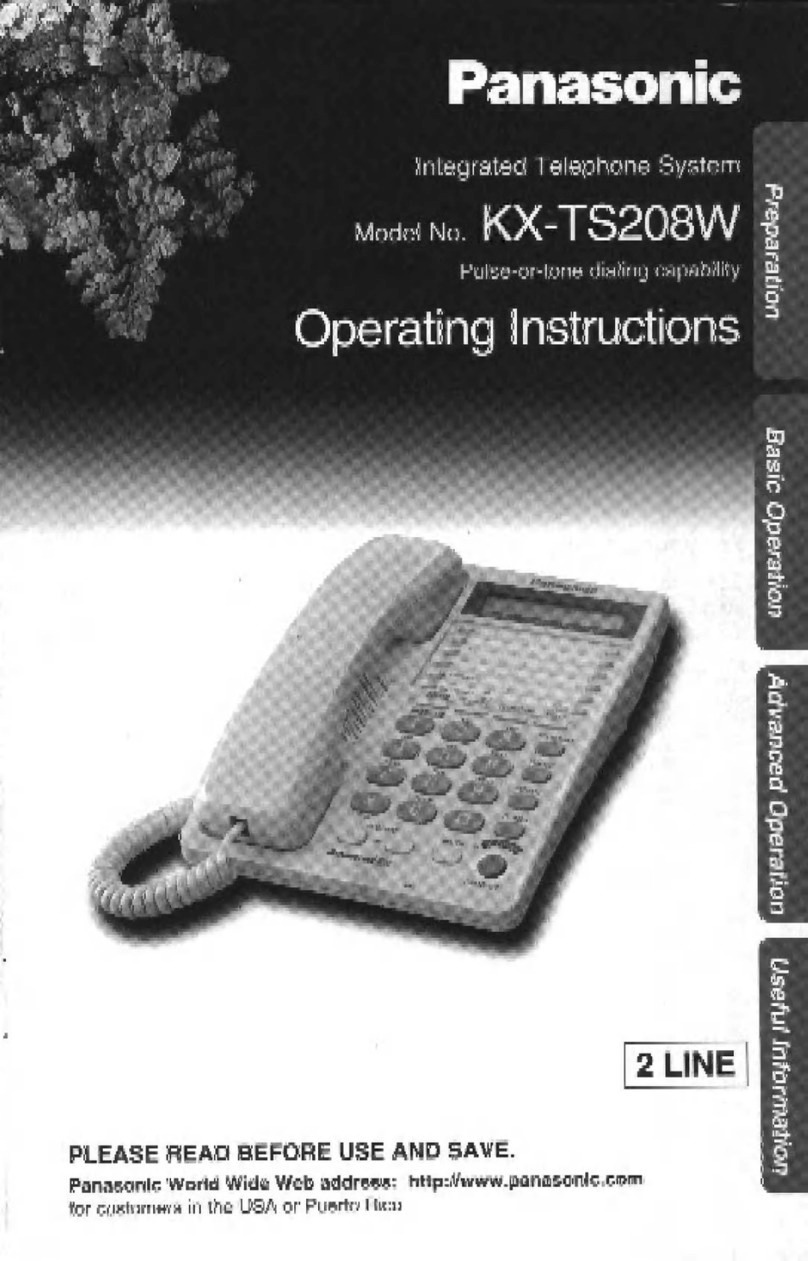
Panasonic
Panasonic KX TS208W operating instructions
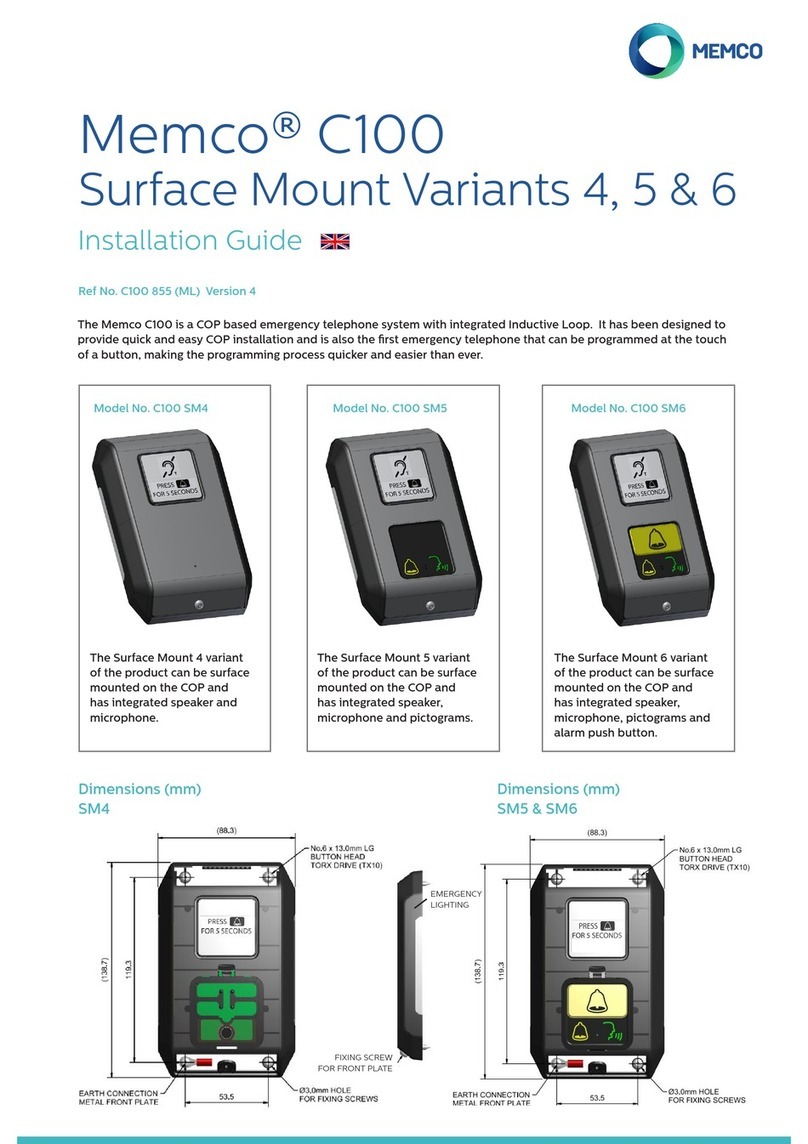
Memco
Memco C100 SM4 installation guide
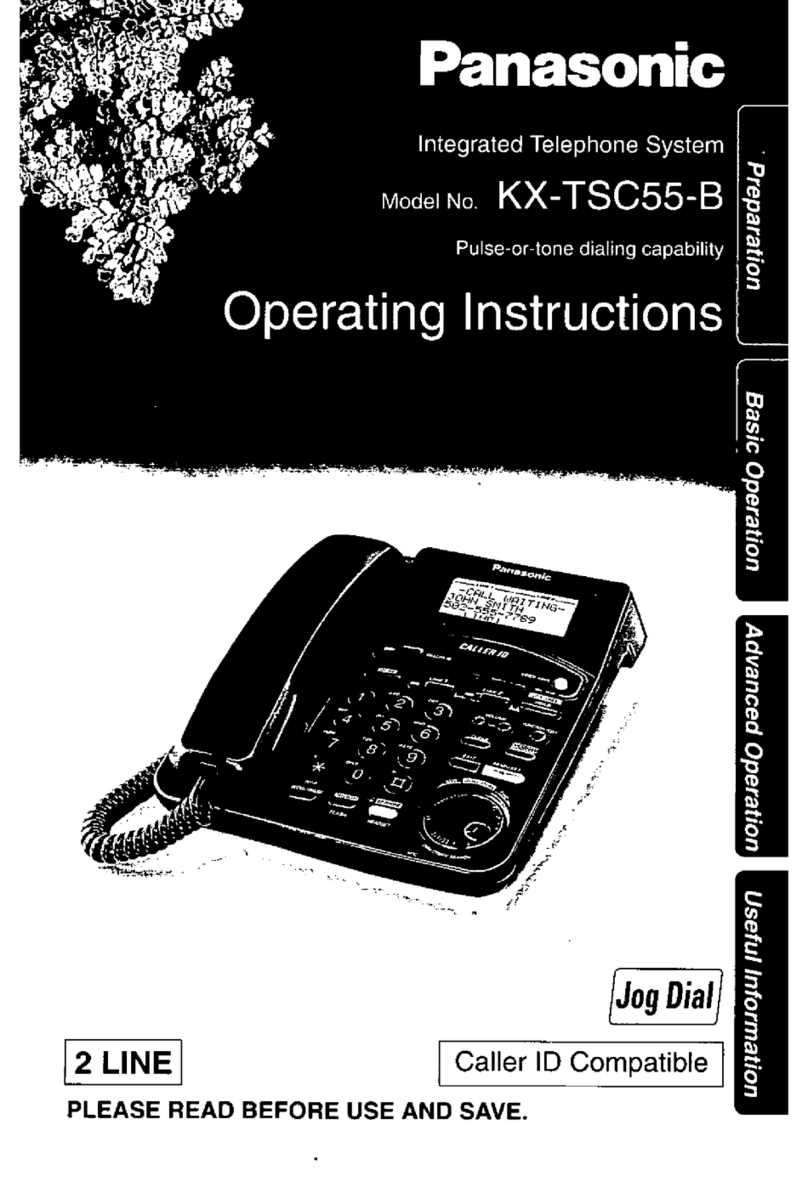
Panasonic
Panasonic KXTSC55B - PHONE/ANSWER MACHINE user guide
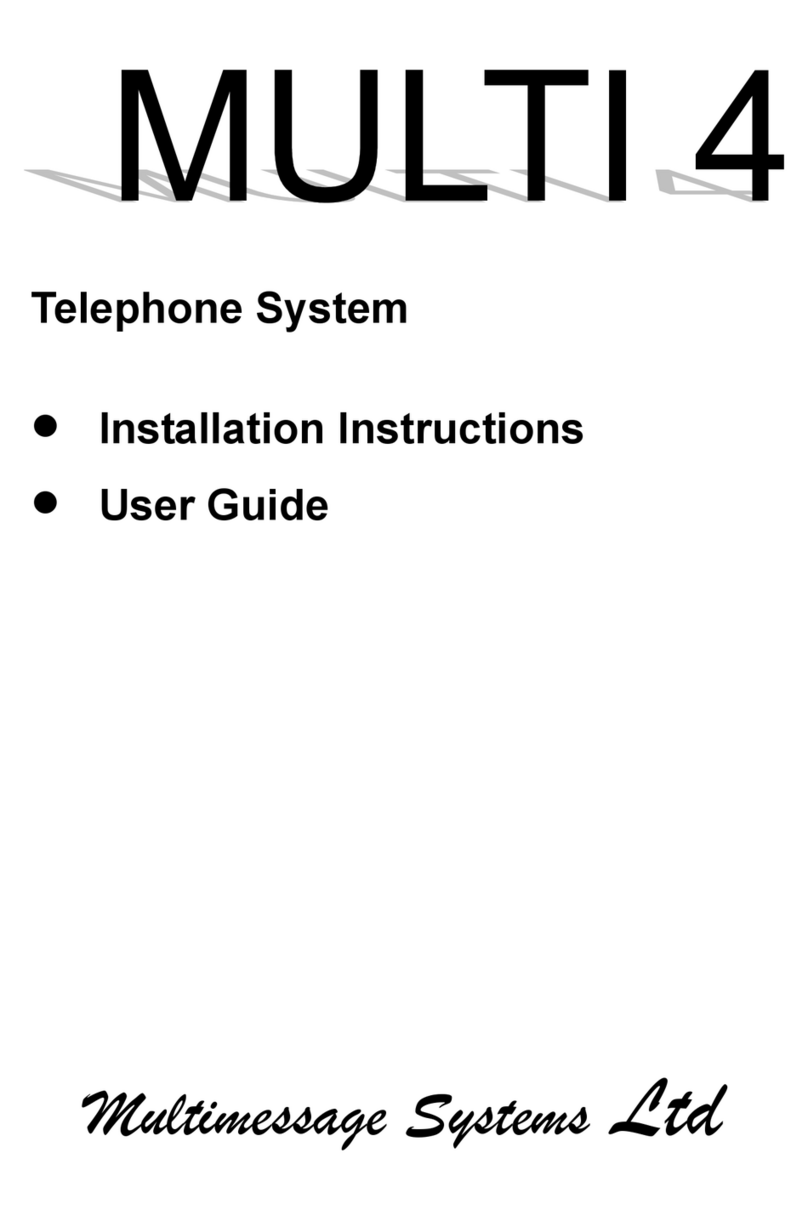
Multimessage Systems
Multimessage Systems Multi 4 Installation and user guide
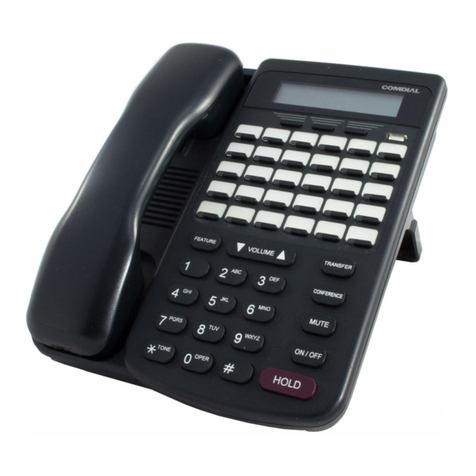
Comdial
Comdial DX-80 Installation & maintenance manual
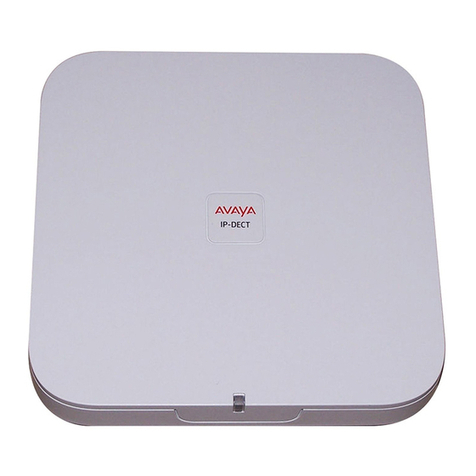
Avaya
Avaya DECT R4 installation guide
